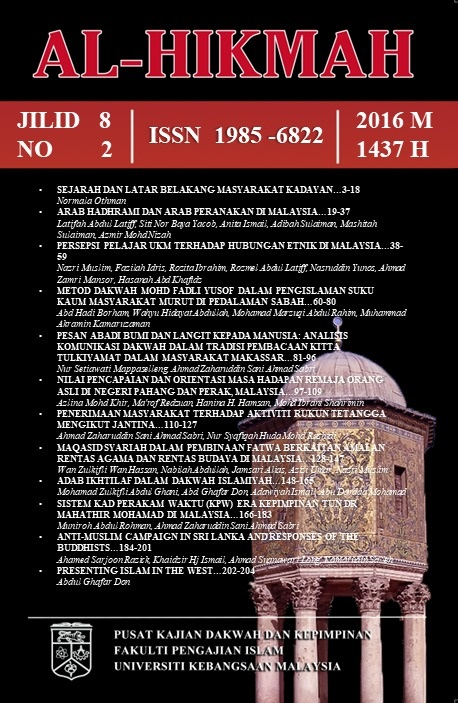PUBLIC ACCEPTANCE OF NEIGHBORHOODS ACTIVITIES BY GENDER
Penerimaan Masyarakat Terhadap Aktiviti Rukun Tetangga Mengikut Jantina
Abstract
Neighborhood Watch (RT) was introduced in 1975. The objective is generally to assess the level of public acceptance of Neighborhood Watch. This study emphasizes the individual participation in Neighborhood Watch, leadership in the neighborhood and interaction among members RT. This study is to identify whether the neighborhood can be accepted by the community, especially through the acceptance of gender and also understanding the population of RT so their involvement in it. A total of 1866 respondents were selected based on a list of registered Neighborhood obtained from the Department of National Unity. The study area includes the states of Kedah Utara Malaysia. Respondents had to respond to a questionnaire given to them by mail. This study used a study design insights. The instrument used was the IBM SPSS 20.0 to analyze the results of the investigation. The study said more than male respondents than female respondents, 57.4% and 42.6%. In addition, the study found the average mean rank to men over women, namely 955.84 and 903.34 in 'workload is not prevented me from doing activities RT. For 'My relationship with RT among other residents' associations which are very closely' more agreed by men, the average mean is 968.66 and women 886.02. Therefore, this study would be beneficial to all parties concerned and the spirit of cooperation between this also proves that the people still maintain the traditional Malay culture.
References
Ahmad Mahdzan Ayob (1985). Kaedah Penyelidikan Sosioekonomi. Kuala Lumpur: Dewan Bahasa dan Pustaka.
Edgement, R.L. & Williams, J. (1998). “Select Leader Using a Quality Management Process.” Quality Progress. Vol. 31. February. M.s. 78-82.
Goldhaber, G.M (1991). Communication in organization. 3rd Edition . Iowa: Wm.C. Brown Company Publishers.
Griffin, R.W. (1990). Management 3rd Edition. Boston: Houghton Mifflin Company.
Hamidah Abu Bakar.(2014). Kepimpinan Rukun tetangga: Satu Kajian Kes di Kawasan Rukun Tetangga Kampung Malaysia Raya, Cheras,Kuala Lumpur, diambil dari http://eprints.usm.my/29025/1/ KEPIMPINAN_RUKUN_TETANGGA._SATU_KAJIAN_KES_DI_KAWASAN_RUKUN_TETANGGA_KAMPUNG_MALAYSIA_RAYA._CHERAS_KUALA_LUMPUR.pdf
Hansen, H.H & Heuser, P.M. (1971). Are Sampling Some Principal Design in Frankin, B.J. and Osborne,H.W. (ed) Research Method:Issue an Insight. California: Wadworth Publishing Company,Inc.
Haron Din.1988.Malaysia dan Islam.Kuala Lumpur: Percetakan Watan
Imam Ghazali, Bimbingan Mu’minin, Singapura: Pustaka National PTE LTD.
Jabatan Perpaduan Negara dan Integrasi Nasional, 2010.
Jacob, C.L & Ary, D. (1990). Introduction to Research in Education. Orlando : Harcourt Brance College Publishers.
Krejcie, R.V., & Morgan, D.W. (1970). Determining Sample Size for Research Activities. Educational and Psychological Measurement. 30,608.
Mohd Majid Konting (1990). Kaedah Penyelidikan Pendidikan. Kuala Lumpur: Dewan Bahasa dan Pustaka.
Mohd Taib Hj Dora. (2006). Kajian Keberkesanan Program Rukun Tetangga Dalam Memupuk Perpaduan dan Integrasi Nasional. Kajian¬-kajian Yang Telah Dijalankan Pada Tahun 2006.
Jabatan Perpaduan Negara Dan Integrasi Nasional
Meor Azam Meor Harun. (2010). Penilaian keberkesanan organisasi jiran muda dalam Kawasan Rukun Tetangga di Taiping, Perak. Unpublished Tesis Master. Universiti Sains Malaysia diambil dari http://www.jpnin.gov.my/documents/10124/1360130/Jurnal+Perpaduan+2015.pdf
Mashitah Sulaiman,Mohd Azmir bin Mohd Nizah,Mohammad Aizuddin bin Abdul Aziz, Memupuk Kesedaran Tanggungjawab Sosial melalui Penglibatan dalam Aktiviti Kejiranan dari Kaca Mata Islam. Pusat Pengajian Umum, Universiti Sains Islam Malaysia diambil dari
Rustomji, M.K. & Sapre, S.A (1992). Seni Pengurusan . Kuala Lumpur : Dewan Bahasa dan Pustaka
Skuad Wanita Meronda Malam(Utusan).Mohd Shariza Abdullah. diterbitkan pada 19/11/2011 diambil dari http://ww1.utusan.com.my/utusan/info.asp?y=2011&dt=1119&pub=Utusan_Malaysia&sec=Keluarga&pg=ke_06.htm#ixzz46cS5pImd
Van Dalen, D. B. 1993. Memahami Penyelidikan Pendidikan : Satu Pengenalan. (ed. ke-4),
terjemahan Abdul Fatah Abd. Malik dan Mohd Majid Konting. Serdang: Penerbit Universiti Pertanian Malaysia
Wanita tidak kekok lakukan rondaan (Sinar Harian). Diterbitkan pada 26/8/2014 diambil dari http://www.sinarharian.com.my/mobile/edisi/kelantan/wanita-tidak-kekok-lakukan-rondaan-1.311223
Yukl, G.(1994). Leadership in Organization. 3rd. Edition. New Jersey : Prentice Hall.
Zarina Muhammad.1997. “Kekeluargaan dan Kemasyarakatan” Dalam Tamadun Islam. Serdang :Universiti Putra Malaysia
Copyright (c) December 2016 Al-Hikmah

This work is licensed under a Creative Commons Attribution-NonCommercial-NoDerivatives 4.0 International License.
Authors retain copyright and grant the journal right of first publication with the work simultaneously licensed under a Creative Commons Attribution License (CC BY-SA 4.0) that allows others to share the work with an acknowledgement of the work's authorship and initial publication in this journal.








